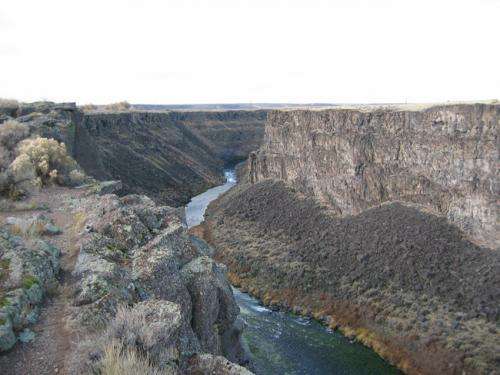Credit: Jim Cash/Idaho Geological Survey
(Phys.org) —A team of researchers is proposing that Idaho's Malad Gorge and two of its three unique heads were created by a massive flood 46,000 years ago. In their paper published in Proceeding of the National Academy of Sciences, the team members from California Institute of Technology describe a field study they undertook of the area and how their findings suggest the gorge was created by a flood, not erosion as has been previously thought.
Gorges and especially canyons inspire awe and wonder in most who view them, followed by introspection and inevitably questions regarding how such a spectacle might have come about. Up till now, the most common answer has been simple erosion—water flowing over a long enough period of time can cut even the hardest of rock. More recently, however, new evidence has suggested that some gorges were actually created by groundwater movement. And now, in this new effort, the research team suggests that some of them might have come about due to massive floods.
To learn more about the origins of Malad Gorge, the team traveled there and collected rock samples from several sites, focusing most specifically on what are known as amphitheater-headed canyons—where the walls of the canyon run straight up and down, and the area around them forms what look like an amphitheater. The prevailing view has been that they form due to erosion. But in their study of the isotopic makeup of the rock samples, they found that two different amphitheater-headed canyons just 11 miles apart were roughly the same age, suggesting something other than erosion was at play. Next, they found that a volcanic eruption that had led to the formation of nearby Butte Basalt had occurred at roughly the same time as well. This led to the team developing a theory that suggests the volcanic eruption and subsequent lava flow caused a change in the course of a river that existed at that time, causing massive flooding of the entire area for some period of time—enough time to have carved out the heads of Woody's Cove and Stubby Canyon.
The researchers note that their findings may explain gorge and cavern formation in other places as well, including other planets, such as some of those on Mars.
More information: Amphitheater-headed canyons formed by megaflooding at Malad Gorge, Idaho, PNAS, Published online before print December 16, 2013, DOI: 10.1073/pnas.1312251111
Abstract
Many bedrock canyons on Earth and Mars were eroded by upstream propagating headwalls, and a prominent goal in geomorphology and planetary science is to determine formation processes from canyon morphology. A diagnostic link between process and form remains highly controversial, however, and field investigations that isolate controls on canyon morphology are needed. Here we investigate the origin of Malad Gorge, Idaho, a canyon system cut into basalt with three remarkably distinct heads: two with amphitheater headwalls and the third housing the active Wood River and ending in a 7% grade knickzone. Scoured rims of the headwalls, relict plunge pools, sediment-transport constraints, and cosmogenic (3He) exposure ages indicate formation of the amphitheater-headed canyons by large-scale flooding ∼46 ka, coeval with formation of Box Canyon 18 km to the south as well as the eruption of McKinney Butte Basalt, suggesting widespread canyon formation following lava-flow diversion of the paleo-Wood River. Exposure ages within the knickzone-headed canyon indicate progressive upstream younging of strath terraces and a knickzone propagation rate of 2.5 cm/y over at least the past 33 ka. Results point to a potential diagnostic link between vertical amphitheater headwalls in basalt and rapid erosion during megaflooding due to the onset of block toppling, rather than previous interpretations of seepage erosion, with implications for quantifying the early hydrosphere of Mars.
Journal information: Proceedings of the National Academy of Sciences
© 2013 Phys.org
























